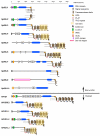The 10 sea urchin receptor for egg jelly proteins (SpREJ) are members of the polycystic kidney disease-1 (PKD1) family
- PMID: 17629917
- PMCID: PMC1934368
- DOI: 10.1186/1471-2164-8-235
The 10 sea urchin receptor for egg jelly proteins (SpREJ) are members of the polycystic kidney disease-1 (PKD1) family
Abstract
Background: Mutations in the human polycystic kidney disease-1 (hPKD1) gene result in ~85% of cases of autosomal dominant polycystic kidney disease, the most frequent human monogenic disease. PKD1 proteins are large multidomain proteins involved in a variety of signal transduction mechanisms. Obtaining more information about members of the PKD1 family will help to clarify their functions. Humans have five hPKD1 proteins, whereas sea urchins have 10. The PKD1 proteins of the sea urchin, Strongylocentrotus purpuratus, are referred to as the Receptor for Egg Jelly, or SpREJ proteins. The SpREJ proteins form a subfamily within the PKD1 family. They frequently contain C-type lectin domains, PKD repeats, a REJ domain, a GPS domain, a PLAT/LH2 domain, 1-11 transmembrane segments and a C-terminal coiled-coil domain.
Results: The 10 full-length SpREJ cDNA sequences were determined. The secondary structures of their deduced proteins were predicted and compared to the five human hPKD1 proteins. The genomic structures of the 10 SpREJs show low similarity to each other. All 10 SpREJs are transcribed in either embryos or adult tissues. SpREJs show distinct patterns of expression during embryogenesis. Adult tissues show tissue-specific patterns of SpREJ expression.
Conclusion: Possession of a REJ domain of about 600 residues defines this family. Except for SpREJ1 and 3, that are thought to be associated with the sperm acrosome reaction, the functions of the other SpREJ proteins remain unknown. The sea urchin genome is one-fourth the size of the human genome, but sea urchins have 10 SpREJ proteins, whereas humans have five. Determination of the tissue specific function of each of these proteins will be of interest to those studying echinoderm development. Sea urchins are basal deuterostomes, the line of evolution leading to the vertebrates. The study of individual PKD1 proteins will increase our knowledge of the importance of this gene family.
Figures



Similar articles
-
The sea urchin sperm receptor for egg jelly is a modular protein with extensive homology to the human polycystic kidney disease protein, PKD1.J Cell Biol. 1996 May;133(4):809-17. doi: 10.1083/jcb.133.4.809. J Cell Biol. 1996. PMID: 8666666 Free PMC article.
-
Identification of a human homologue of the sea urchin receptor for egg jelly: a polycystic kidney disease-like protein.Hum Mol Genet. 1999 Mar;8(3):543-9. doi: 10.1093/hmg/8.3.543. Hum Mol Genet. 1999. PMID: 9949214
-
Comparative analysis of the polycystic kidney disease 1 (PKD1) gene reveals an integral membrane glycoprotein with multiple evolutionary conserved domains.Hum Mol Genet. 1997 Sep;6(9):1483-9. doi: 10.1093/hmg/6.9.1483. Hum Mol Genet. 1997. PMID: 9285785
-
Polycystins: what polycystic kidney disease tells us about sperm.Mol Reprod Dev. 2004 Apr;67(4):385-8. doi: 10.1002/mrd.20042. Mol Reprod Dev. 2004. PMID: 14991728 Review.
-
suREJ proteins: new signalling molecules in sea urchin spermatozoa.Zygote. 2000;8 Suppl 1:S28-30. Zygote. 2000. PMID: 11191296 Review. No abstract available.
Cited by
-
Uncovering the genetic basis for early isogamete differentiation: a case study of Ectocarpus siliculosus.BMC Genomics. 2013 Dec 21;14:909. doi: 10.1186/1471-2164-14-909. BMC Genomics. 2013. PMID: 24359479 Free PMC article.
-
Evidence that polycystins are involved in Hydra cnidocyte discharge.Invert Neurosci. 2017 Mar;17(1):1. doi: 10.1007/s10158-016-0194-3. Epub 2017 Jan 11. Invert Neurosci. 2017. PMID: 28078622
-
Differences and Similarities: The Richness of Comparative Sperm Physiology.Physiology (Bethesda). 2020 May 1;35(3):196-208. doi: 10.1152/physiol.00033.2019. Physiology (Bethesda). 2020. PMID: 32293232 Free PMC article. Review.
-
Adhesion GPCRs as a paradigm for understanding polycystin-1 G protein regulation.Cell Signal. 2020 Aug;72:109637. doi: 10.1016/j.cellsig.2020.109637. Epub 2020 Apr 16. Cell Signal. 2020. PMID: 32305667 Free PMC article. Review.
-
Selection in the rapid evolution of gamete recognition proteins in marine invertebrates.Cold Spring Harb Perspect Biol. 2011 Nov 1;3(11):a002931. doi: 10.1101/cshperspect.a002931. Cold Spring Harb Perspect Biol. 2011. PMID: 21730046 Free PMC article. Review.
References
-
- Bradham CA, Foltz KR, Beane WS, Arnone MI, Rizzo F, Coffman JA, Mushegian A, Goel M, Morales J, Geneviere AM, Lapraz F, Robertson AJ, Kelkar H, Loza-Coll M, Townley IK, Raisch M, Roux MM, Lepage T, Gache C, McClay DR, Manning G. The sea urchin kinome: a first look. Dev Biol. 2006;300:180–193. doi: 10.1016/j.ydbio.2006.08.074. - DOI - PubMed
Publication types
MeSH terms
Substances
Grants and funding
LinkOut - more resources
Full Text Sources
Miscellaneous

